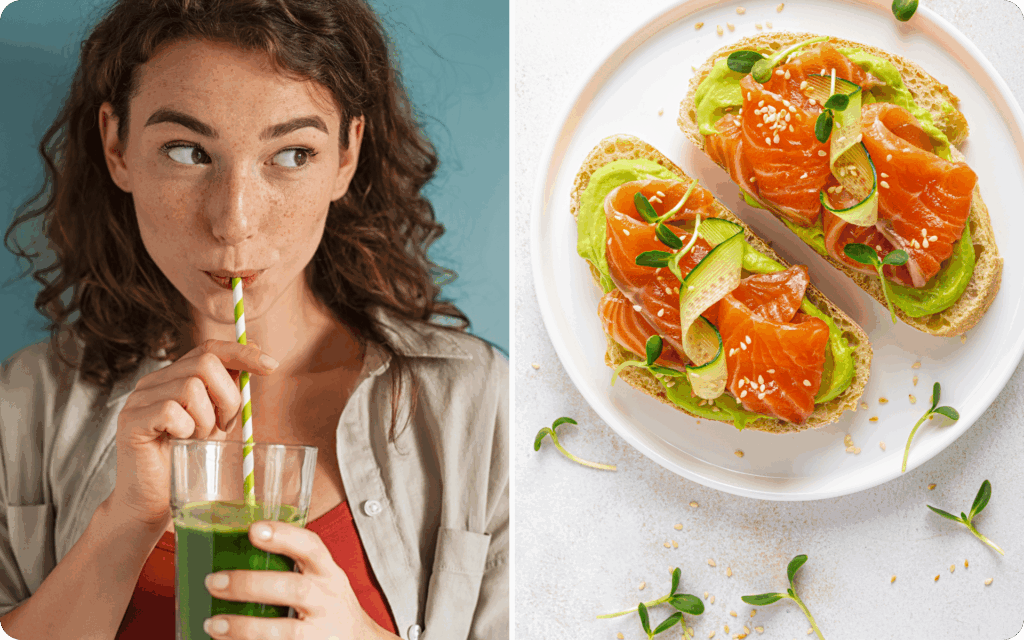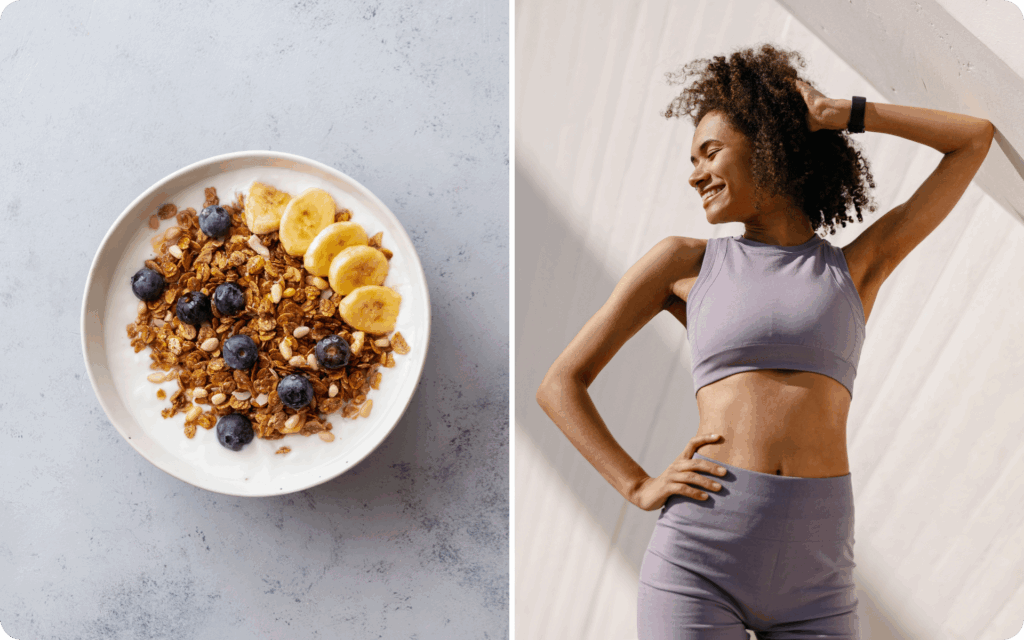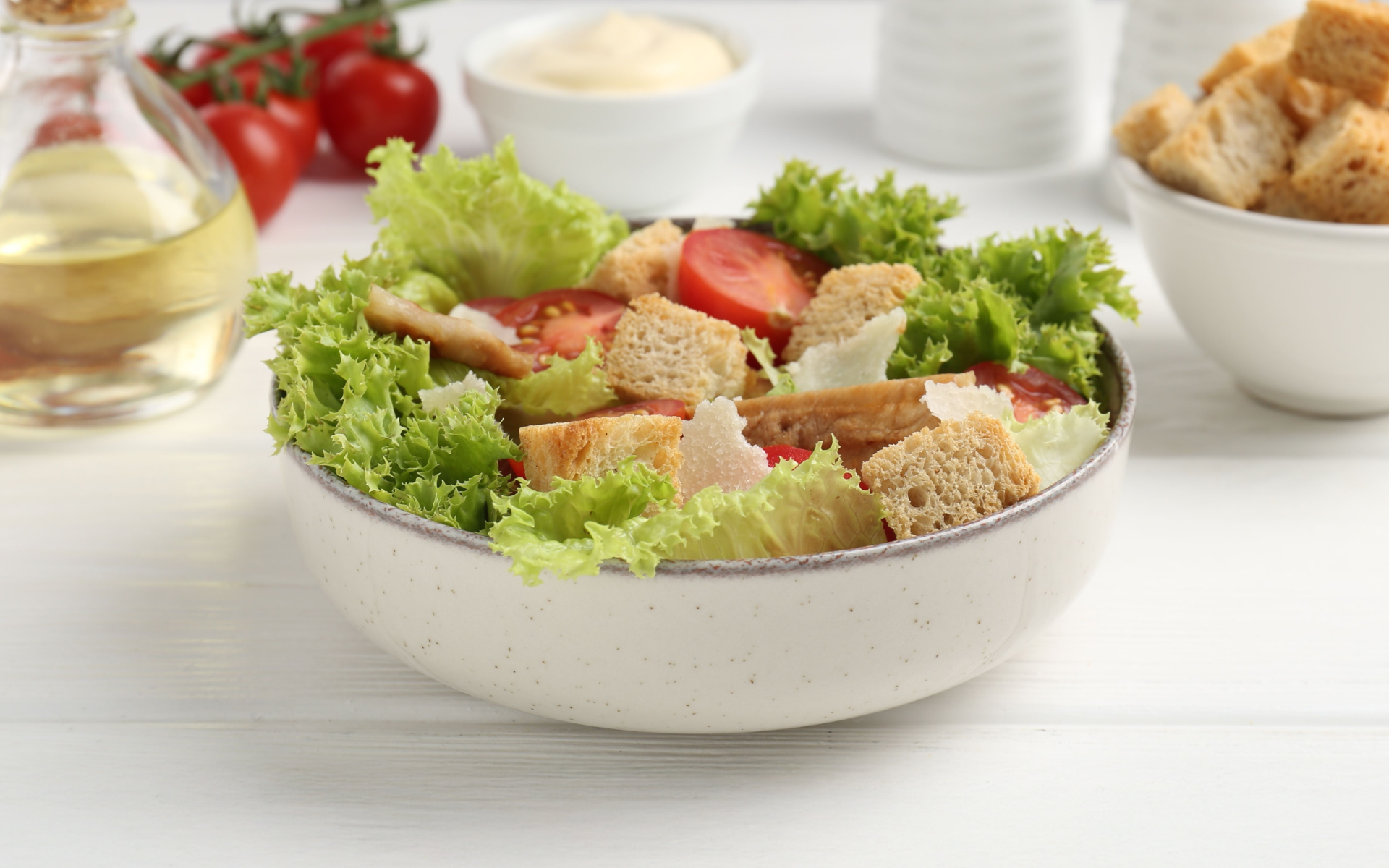Fiber is one of the most underrated components of a healthy diet. While it’s often associated with digestive health, and for good reason, fiber benefits go far beyond just helping you go to the bathroom.
Fiber is key in helping improve blood sugar regulation, supporting heart health, satiety, and even immune function. However, despite all the good things fiber has to offer, most people fall short of their daily fiber needs.
Aiming for a 25-gram fiber meal plan properly planned and designed can help you bridge that gap in a sustainable, digestion-friendly way. But what does it look like to eat 25 grams of fiber daily? Is it enough?
Let’s dive into the science, benefits, and strategies to help you reach a fiber-rich diet.
What Is a Digestion-Friendly 25-Gram Fiber Meal Plan?
While fiber is often associated with helping with bowel movements, many people also associate “high-fiber” with bloating or discomfort. This is especially true when you add fiber suddenly or in large amounts.
That’s why this plan focuses on gradually increasing fiber intake, gentle sources, and meals that are easy to digest while still meeting daily needs.
Aiming for a digestion-friendly 25-gram fiber meal plan is a great starting point, including fiber from whole, plant-based foods, without overwhelming your digestive system.
The key is to include a balance of soluble and insoluble fiber, spread it evenly throughout your meals and snacks, and pair it with plenty of water and movement to support regularity, comfort, and overall gut health (1).
Read more: What Is A Gentle Detox Diet Meal Plan?
Is 25 Grams of Fiber Healthy?
While fiber intake recommendations vary according to age and sex, 25 grams per day is generally considered healthy and safe. It’s a good target for most women, and can be a starting point for many men who are aiming to increase their recommended amounts.
The average fiber intake for adults in North America is between 15 and 17 grams per day, quite below the recommended amount (2, 3).
Whether you’re a workout beast or just a beginner making your first foray into the world of fitness and dieting – BetterMe has a lot to offer to both newbies and experts! Install the app and experience the versatility first-hand!
According to the Food and Drug Administration (FDA), the recommended daily fiber intake for adults following a 2,000-calorie diet is about 28 grams (14 grams per 1,000 calories). However, individual needs vary slightly based on age and sex. The Dietary Guidelines for Americans recommend the following for adults (4, 5):
- Women under 50: 25 to 28 grams per day
- Men under 50: 31 to 34 grams per day
- Women 51 and older: 22 grams per day
- Men 51 and older: 28 grams per day
With this in mind, aiming for at least 25 grams of fiber daily can be a great starting point for most adults, as it helps improve digestion, prevents constipation, and reduces the risk of chronic diseases like type 2 diabetes, heart disease, and colorectal cancer, without overwhelming your digestive system.
It’s worth mentioning that this information is meant for general guidance and doesn’t replace personalized medical advice. It’s always a good idea to check with your doctor or a registered dietitian first if you have any pre-existing health conditions, digestive concerns, or plans to make significant changes to your diet.
What Happens when You Eat 25 Grams of Fiber Every Day?
Eating 25 grams of fiber consistently each day does a lot more than just keep things moving. It can contribute to noticeable improvements in both your short- and long-term health. To learn more about the high-fiber high-protein meal plan, check out our in-depth article on the topic.
Let’s explore fiber’s most important health benefits (6, 7, 8):
- Improves bowel regularity: Fiber helps bulk up and soften your stool, which helps reduce or prevent constipation. This is particularly true for insoluble fiber, which is found in whole wheat, wheat bran, quinoa, brown rice, legumes, leafy greens such as kale, almonds, walnuts, seeds, and fruits with edible skins such as pears and apples. However, soluble fiber can also help soften the stool, making it easier to pass.
- Helps control blood sugar levels: Both types, but especially soluble fiber, such as that found in oatmeal, chia seeds, nuts, beans, lentils, apples, and blueberries, can help slow down sugar absorption into your bloodstream, which can help keep blood sugar levels steady. This is particularly important for people with or at risk of type 2 diabetes.
- Helps reduce cholesterol: Soluble fiber can bind with cholesterol particles, removing them from the body. This helps reduce LDL cholesterol, also known as “bad” cholesterol, over time. This helps reduce the risk of heart disease.
- Improves satiety and weight management: Fiber is one of the most satiating nutrients – it helps slow digestion, making you feel full longer. This can naturally lead to reduced calorie intake and help prevent overeating, thereby helping with weight management.
- Reduces the risk of disease: A fiber-rich diet has been associated with lower risks of several diseases, including colorectal cancer, cardiovascular disease, and type 2 diabetes.
- Happier gut microbiome: Some types of fiber have prebiotic properties. This means they’re food for the beneficial bacteria present in your gut. A healthy gut microbiome is the key to overall health, as it supports immune function, mental health, and nutrient absorption.
How to Get 25 Grams of Fiber per Day
Hitting 25 grams of fiber per day may seem daunting at first, but with a bit of planning and patience, you can reach this goal. Remember, if you’re not used to eating too many fiber-rich foods, it’s best to start slow and increase gradually to avoid any digestive discomfort.
The goal to hit the 25-gram target is to include fiber in every meal and snack. Focus on whole, plant-based foods: fruits, vegetables, legumes, whole grains, seeds, and nuts.
Let’s see a sample breakdown of meals and fiber contributions:
Breakfast: Oatmeal with berries and chia seeds (8-10g)
Lunch: Lentil soup with whole-grain toast and avocado (8-9g)
Dinner: Grilled tofu with quinoa and roasted vegetables (7-8g)
Snack: Apple with almond butter or a handful of trail mix (4-5g)
Total fiber intake: 27 to 32 grams.
Keep in mind that hydration is essential. As you increase your fiber intake, always increase your water intake too. This prevents fiber from sitting stagnant in your gut, which can otherwise cause bloating or gas (1). Exercise and movement in general are also very helpful to keep things moving.
Read more: Rainbow Diet Meal Plan: Your Daily Colorful Health Booster
What Foods Are High in Fiber?
Now that you know why increasing your fiber intake can do wonders for your overall health, let’s dig deeper into what foods are fiber superstars, particularly when they’re in their whole, minimally processed form.
Including a variety of these with your meals and snacks can easily help you hit your daily fiber target, and variety in plant foods also means variety in vitamins and minerals and beneficial plant compounds, so it’s a win-win!
Here’s a breakdown of the top fiber-rich food categories (9, 10):
Legumes: These foods are among the highest fiber options you can have and they’re rich in both soluble and insoluble types. Per cup of cooked legumes, there is approximately:
- Navy/white beans: ~ 18 g
- Split peas: ~16g per
- Lentils/ Black beans: ~15g
- Lima beans: ~ 13 g
- Chickpeas: ~12g
When it comes to weight loss, progress is made by inches, not miles, so it’s much harder to track and a lot easier to give up. The BetterMe: Health Coaching app is your personal trainer, nutritionist, and support system all in one. Start using our app to stay on track and hold yourself accountable!
Whole Grains: Choosing whole intact grains over refined ones is the best option to get the most fiber.
- Oats: ~4g per ½ cup dry
- Barley: ~6g per cup cooked
- Quinoa: ~5g per cup cooked
- Brown rice: ~3.5g per cup cooked
- Whole grain bread: ~3–5g per slice (check labels)
Vegetables: This is another excellent yet underrated food group that can do wonders for your health, not just for fiber intake. They’re also rich in water and tons of vitamins and minerals.
- Artichokes: ~10g per medium artichoke
- Brussels sprouts: ~4g per ½ cup cooked
- Carrots: ~3.5g per cup raw
- Sweet potatoes (with skin): ~4g per medium sweet potato
- Green peas: ~4g per ½ cup cooked
- Broccoli: ~5g per cup cooked
- Spinach: ~4g per cup cooked
- Beets: ~3g per cup cooked
- Butternut squash: ~3g per cup cooked
Fruits: Also rich in fiber, water, and tons of vitamins and minerals. Fruits with edible skins or seeds tend to be higher in fiber.
- Raspberries: ~8g per cup
- Pears (with skin): ~5–6g each
- Apples (with skin): ~4–5g each
- Bananas: ~3g each
- Blackberries: ~8g per cup
- Oranges: ~3–4g each
- Kiwi: ~2–3g each
- Mango: ~5g per fruit
Nuts and Seeds: Tiny but mighty, all seeds and nuts are excellent fiber boosters. Just choose plain ones, with no added salt or sugars.
- Chia seeds: ~10g per 2 tbsp
- Flaxseeds (ground): ~5.5g per 2 tbsp
- Sesame seeds: ~3.5g per 2 tbsp
- Hemp seeds: ~2g per 2 tbsp
- Sunflower seeds: ~3g per ¼ cup
- Pumpkin seeds: ~2.5g per ¼ cup
- Almonds: ~3.5g per ¼ cup
- Pistachios: ~3g per ¼ cup
- Walnuts: ~2g per ¼ cup
- Hazelnuts: ~2.5g per ¼ cup
- Pecans: ~2.7g per ¼ cup
To get the full benefit of these foods, try to mix different categories throughout your day – legumes in soups, seeds in breakfast bowls, vegetables in dinners, and fruit in snacks. This boosts your fiber intake, provides a wider range of nutrients, and is gentler on digestion.
What Are Good Fiber Snacks?
Snacking mindfully and smartly is one of the easiest ways to add fiber to your day. The key is to choose whole, minimally processed foods. Here are some excellent high-fiber options:
- Fresh fruit with skin (apple, pear, raspberries, figs)
- Raw vegetables with hummus (carrots, cucumbers, snap peas)
- Chia pudding made with plant-based milk and a little fruit
- Trail mix with nuts, seeds, and a few dried fruits
- Whole-grain crackers with guacamole or nut butter
- Roasted chickpeas or edamame
- Popcorn (air-popped, no butter)
Aim for snacks that deliver at least 3 grams of fiber per serving to make a meaningful contribution.
Frequently Asked Questions
What drink is high in fiber?
Generally, most drinks are low in fiber. However, there are a few options you can consider. For example, blended smoothies with fruits, vegetables, chia, or flaxseeds, including their pulp, will increase the fiber content. In addition, adding psyllium husk to your water or juice can also help boost fiber intake – just 1 tsp per serving.
Are cucumbers high in fiber?
Cucumbers are one of the vegetables that are lowest in calories, but they’re also relatively low in fiber. One whole cucumber (with skin) has approximately 2g of fiber, mostly insoluble. While refreshing and hydrating, they aren’t a major fiber source. However, they can contribute to your total when eaten with other vegetables, so don’t neglect them.
Is yogurt high in fiber?
Plain yogurt (regardless of fat content or flavour type) doesn’t have any fiber as it’s an animal product. However, some plant-based yogurts (such as almond, oat, or coconut milk-based varieties) can be fortified with added fiber. Yogurt can be a great ally for a wholesome diet though, and just by adding some nuts, seeds, or fresh fruit, you can boost your fiber intake.
What are high-fiber, low-calorie foods?
Some of the best high-fiber foods with relatively few calories include leafy greens (such as spinach, kale, and arugula), broccoli, cauliflower, Brussels sprouts, zucchini, squash, berries, chia seeds (tons of fiber in a small portion size), air popcorn (no butter), cabbage, celery, and carrots. These foods can help you feel fuller for longer, helping with fiber intake without adding many calories, which makes them ideal for weight loss and digestive health.
The Bottom Line
Hitting 25 grams of fiber a day isn’t just about going to the bathroom more often, it’s also about making a daily investment to improve your heart health, blood sugar, and weight management, and may also aid immune function.
Adding a variety of fiber-rich foods such as fruits, vegetables, legumes, whole grains, nuts, and seeds can make the target both achievable and enjoyable. The key is to spread fiber throughout the day, balance soluble and insoluble sources, and pair them with plenty of water to keep your digestion comfortable.
If you’re not used to eating much fiber, a gradual approach is essential. By increasing your intake slowly, choosing gentle, whole-food sources, and paying attention to your body’s response, you can reap the benefits without the discomfort that sometimes comes from a sudden jump in fiber consumption.
DISCLAIMER:
This article is intended for general informational purposes only and does not serve to address individual circumstances. It is not a substitute for professional advice or help and should not be relied on for making any kind of decision-making. Any action taken as a direct or indirect result of the information in this article is entirely at your own risk and is your sole responsibility.
BetterMe, its content staff, and its medical advisors accept no responsibility for inaccuracies, errors, misstatements, inconsistencies, or omissions and specifically disclaim any liability, loss or risk, personal, professional or otherwise, which may be incurred as a consequence, directly or indirectly, of the use and/or application of any content.
You should always seek the advice of your physician or other qualified health provider with any questions you may have regarding a medical condition or your specific situation. Never disregard professional medical advice or delay seeking it because of BetterMe content. If you suspect or think you may have a medical emergency, call your doctor.
SOURCES:
- Dietary fiber: Essential for a healthy diet (n.d, mayoclinic.org)
- Increasing Fiber Intake (n.d, ucsfhealth.org)
- Fibre intake for optimal health: how can healthcare professionals support people to reach dietary recommendations? (2022, ncbi.nlm.nih.gov)
- Daily Value on the Nutrition and Supplement Facts Labels (n.d, fda.gov)
- Dietary Guidelines for Americans (2020, dietaryguidelines.gov)
- The Health Benefits of Dietary Fibre (2020, ncbi.nlm.nih.gov)
- Fiber (n.d, hsph.harvard.edu)
- Fiber: The Carb That Helps You Manage Diabetes (n.d, cdc.gov)
- Dietary fibre in foods: a review (2011, ncbi.nlm.nih.gov)
- Food Sources of Dietary Fiber (2020, dietaryguidelines.gov)















